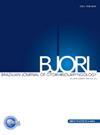Analysis of the frontal recess pneumatization pattern in patients with chronic frontal sinusopathy
IF 1.7
4区 医学
Q2 OTORHINOLARYNGOLOGY
引用次数: 0
Abstract
Objectives
To analyze the pneumatization pattern of the frontal recess using CT scans and to determine the prevalence of frontoethmoidal cells and their possible correlation with the development of sinusopathy.
Methods
By means of a retrospective, analytical and cross-sectional study, 300 CT scans of patients with clinical suspicion of chronic rhinosinusitis were examined, separately on the right and left sides, totaling a sample of 600 paranasal sinuses, with regard to the presence of frontal cells, the presence of blockage or veiling of the recess and frontal sinus.
Results
Frontoethmoidal cells were present in 85.8% of cases; the most frequent cells were supra bulla cells, in 43.8%, and the least frequent were supraorbital ethmoid cells, in 11% of cases. There was a 35% prevalence of supra-Agger cells, 15.8% of supra-Agger frontal cells, 20.2% of supra bulla frontal cells and 12.3% of frontal septal cells. A significant relationship was found between the presence of supra-Agger frontal cells and supra bulla frontal cells and the development of sinusopathy.
Conclusion
The supra-Agger frontal cells and supra bulla frontal cells, when present in the frontal recess, predispose to the development of frontal sinusopathy. Therefore, preoperative tomographic analysis allows a three-dimensional anatomical understanding of the recess and frontal sinus based on determining the pneumatization pattern of this region.
Level of evidence
Level 3.
目的 通过 CT 扫描分析额叶凹陷的气化模式,确定额叶细胞的发病率及其与鼻窦病变发展的可能相关性。方法 通过一项回顾性、分析性和横断面研究,对临床怀疑患有慢性鼻窦炎的 300 名患者的 CT 扫描结果进行检查,分别检查左右两侧共 600 个副鼻窦样本,以确定是否存在额叶细胞、凹陷和额窦是否存在堵塞或遮盖。结果 85.8%的病例存在额叶细胞;最常见的是鼓室上细胞,占 43.8%,最少的是眶上乙状窦细胞,占 11%。眶上细胞的发病率为 35%,眶上额叶细胞的发病率为 15.8%,鼓上额叶细胞的发病率为 20.2%,额隔细胞的发病率为 12.3%。研究发现,额叶上阿格细胞和额叶上鼓室细胞的存在与额窦病变的发生有重要关系。因此,通过术前断层扫描分析,可以在确定该区域气化模式的基础上,对额凹和额窦进行三维解剖了解。
本文章由计算机程序翻译,如有差异,请以英文原文为准。
求助全文
约1分钟内获得全文
求助全文
来源期刊

Brazilian Journal of Otorhinolaryngology
OTORHINOLARYNGOLOGY-
CiteScore
3.00
自引率
0.00%
发文量
205
审稿时长
4-8 weeks
期刊介绍:
Brazilian Journal of Otorhinolaryngology publishes original contributions in otolaryngology and the associated areas (cranio-maxillo-facial surgery and phoniatrics). The aim of this journal is the national and international divulgation of the scientific production interesting to the otolaryngology, as well as the discussion, in editorials, of subjects of scientific, academic and professional relevance.
The Brazilian Journal of Otorhinolaryngology is born from the Revista Brasileira de Otorrinolaringologia, of which it is the English version, created and indexed by MEDLINE in 2005. It is the official scientific publication of the Brazilian Association of Otolaryngology and Cervicofacial Surgery. Its abbreviated title is Braz J Otorhinolaryngol., which should be used in bibliographies, footnotes and bibliographical references and strips.
 求助内容:
求助内容: 应助结果提醒方式:
应助结果提醒方式:


